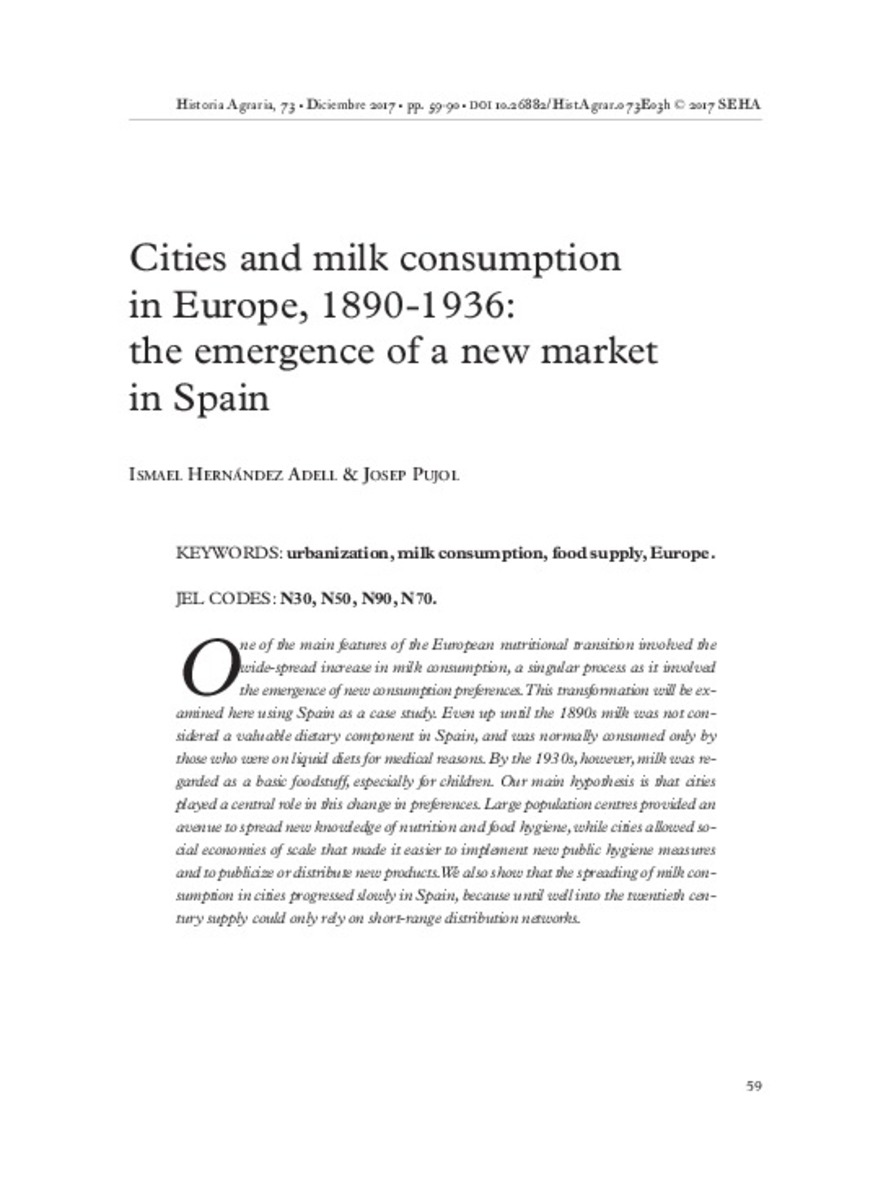Mostrar el registro sencillo del ítem
Cities and milk consumption in Europe, 1890-1936: the emergence of a new market in Spain
| dc.contributor.author | Hernández Adell, Ismael | |
| dc.contributor.author | Pujol Andreu, Josep | |
| dc.date.accessioned | 2018-03-04T17:13:31Z | |
| dc.date.available | 2018-03-04T17:13:31Z | |
| dc.date.issued | 2017-12 | |
| dc.identifier.issn | 1139-1472 | |
| dc.identifier.uri | http://hdl.handle.net/10234/173189 | |
| dc.description.abstract | One of the main features of the European nutritional transition involved the wide-spread increase in milk consumption, a singular process as it involved the emergence of new consumption preferences. This transformation will be examined here using Spain as a case study. Even up until the 1890s milk was not considered a valuable dietary component in Spain, and was normally consumed only by those who were on liquid diets for medical reasons. By the 1930s, however, milk was regarded as a basic foodstuff, especially for children. Our main hypothesis is that cities played a central role in this change in preferences. Large population centres provided an avenue to spread new knowledge of nutrition and food hygiene, while cities allowed social economies of scale that made it easier to implement new public hygiene measures and to publicize or distribute new products. We also show that the spreading of milk consumption in cities progressed slowly in Spain, because until well into the twentieth century supply could only rely on short-range distribution networks. | ca_CA |
| dc.description.abstract | La difusión del consumo de leche fue una de las principales características de la transición nutricional europea. Este proceso fue además muy singular, porque exigió la formación de nuevas preferencias de consumo. En este artículo examinaremos esta cuestión tomando como referencia España. En este caso, todavía en los años 1890 la leche era un alimento muy poco valorado por la sociedad y normalmente solo la consumían aquellos colectivos que precisaban ingerir dietas líquidas. En los años 1930, en cambio, la leche era considerada un alimento de primera necesidad, especialmente para los menores de edad. Nuestra principal hipótesis es que las ciudades ocuparon un lugar destacado en este proceso, porque fue en estos núcleos de población donde antes se difundieron los nuevos conocimientos en nutrición e higiene de los alimentos, y donde las economías sociales de escala hacían más fácil impulsar nuevas políticas de higiene pública y la difusión de nuevos productos. También mostraremos que la difusión del consumo de leche avanzó muy lentamente en España, porque el abastecimiento debió ser de proximidad hasta muy entrado el siglo xx. | ca_CA |
| dc.format.extent | 31 p. | ca_CA |
| dc.format.mimetype | application/pdf | ca_CA |
| dc.language.iso | eng | ca_CA |
| dc.publisher | Sociedad Española de Historia Agraria (SEHA) | ca_CA |
| dc.relation.isPartOf | Historia agraria: Revista de agricultura e historia rural, nº 73, 59-90 | |
| dc.rights | © 2017 SEHA | ca_CA |
| dc.rights | Attribution-NonCommercial-NoDerivatives 4.0 Internacional | * |
| dc.rights.uri | http://creativecommons.org/licenses/by-nc-nd/4.0/ | * |
| dc.subject | urbanización | ca_CA |
| dc.subject | consumo de leche | ca_CA |
| dc.subject | alimentos | ca_CA |
| dc.subject | España | ca_CA |
| dc.subject | Spain | ca_CA |
| dc.subject | milk consumption | ca_CA |
| dc.subject | food suply | ca_CA |
| dc.subject | urbanization | ca_CA |
| dc.subject | Europe | ca_CA |
| dc.title | Cities and milk consumption in Europe, 1890-1936: the emergence of a new market in Spain | ca_CA |
| dc.type | info:eu-repo/semantics/article | ca_CA |
| dc.subject.jel | N30 | ca_CA |
| dc.subject.jel | N50 | ca_CA |
| dc.subject.jel | N70 | ca_CA |
| dc.subject.jel | N90 | ca_CA |
| dc.identifier.doi | http://dx.doi.org/10.26882/HistAgrar.073E03h | |
| dc.rights.accessRights | info:eu-repo/semantics/openAccess | ca_CA |
| dc.relation.publisherVersion | http://www.historiaagraria.com/numero.php?n=73 | ca_CA |








